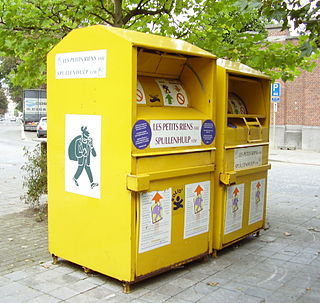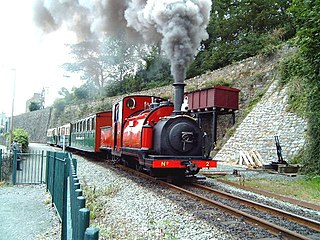Industrial ecology (IE) is the study of material and energy flows through industrial systems. The global industrial economy can be modelled as a network of industrial processes that extract resources from the Earth and transform those resources into by-products, products and services which can be bought and sold to meet the needs of humanity. Industrial ecology seeks to quantify the material flows and document the industrial processes that make modern society function. Industrial ecologists are often concerned with the impacts that industrial activities have on the environment, with use of the planet's supply of natural resources, and with problems of waste disposal. Industrial ecology is a young but growing multidisciplinary field of research which combines aspects of engineering, economics, sociology, toxicology and the natural sciences.

Service economy can refer to one or both of two recent economic developments:
In business analysis, PEST analysis describes a framework of macro-environmental factors used in the environmental scanning component of strategic management. It is part of an external environment analysis when conducting a strategic analysis or doing market research, and gives an overview of the different macro-environmental factors to be taken into consideration. It is a strategic tool for understanding market growth or decline, business position, potential and direction for operations.

A biorefinery is a refinery that converts biomass to energy and other beneficial byproducts. The International Energy Agency Bioenergy Task 42 defined biorefining as "the sustainable processing of biomass into a spectrum of bio-based products and bioenergy ". As refineries, biorefineries can provide multiple chemicals by fractioning an initial raw material (biomass) into multiple intermediates that can be further converted into value-added products. Each refining phase is also referred to as a "cascading phase". The use of biomass as feedstock can provide a benefit by reducing the impacts on the environment, as lower pollutants emissions and reduction in the emissions of hazard products. In addition, biorefineries are intended to achieve the following goals:
- Supply the current fuels and chemical building blocks
- Supply new building blocks for the production of novel materials with disruptive characteristics
- Creation of new jobs, including rural areas
- Valorization of waste
- Achieve the ultimate goal of reducing GHG emissions

Material efficiency is a description or metric (Mp) (the ratio of material used to the supplied material) which refers to decreasing the amount of a particular material needed to produce a specific product. Making a usable item out of thinner stock than a prior version increases the material efficiency of the manufacturing process. Material efficiency goes hand in hand with Green building and Energy conservation, as well as other ways of incorporating Renewable resources in the building process from start to finish.
A sustainable business, or a green business, is an enterprise that has a minimal negative impact or potentially a positive effect on the global or local environment, community, society, or economy—a business that strives to meet the triple bottom line. They cluster under different groupings and the whole is sometimes referred to as "green capitalism." Often, sustainable businesses have progressive environmental and human rights policies. In general, a business is described as green if it matches the following four criteria:
- It incorporates principles of sustainability into each of its business decisions.
- It supplies environmentally friendly products or services that replace demand for nongreen products and/or services.
- It is greener than traditional competition.
- It has made an enduring commitment to environmental principles in its business operations.
Precycling is the practice of reducing waste by attempting to avoid buying items which will generate waste into home or business. The U.S. Environmental Protection Agency (EPA) also cites that precycling is the preferred method of integrated solid waste management because it cuts waste at its source and therefore trash is eliminated before it is created. According to the EPA, precycling is also characterized as a decision-making process on the behalf of the consumer because it involves making informed judgments regarding a product's waste implications. The implications that are taken into consideration by the consumer include: whether a product is reusable, durable, or repairable; made from renewable or non-renewable resources; over-packaged; and whether or not the container is reusable.
Design for the Environment (DfE) is a design approach to reduce the overall human health and environmental impact of a product, process or service, where impacts are considered across its life cycle. Different software tools have been developed to assist designers in finding optimized products or processes/services. DfE is also the original name of a United States Environmental Protection Agency (EPA) program, created in 1992, that works to prevent pollution, and the risk pollution presents to humans and the environment. The program provides information regarding safer chemical formulations for cleaning and other products. EPA renamed its program "Safer Choice" in 2015.

Textile recycling is the process of recovering fiber, yarn, or fabric and reprocessing the material into new, useful products. Textile waste is split into pre-consumer and post-consumer waste and is sorted into five different categories derived from a pyramid model. Textiles can be either reused or mechanically/chemically recycled.

Product lifetime or product lifespan is the time interval from when a product is sold to when it is discarded.
Sustainable product development (SPD) is a method for product development that incorporates a Framework for Strategic Sustainable Development (FSSD), also known as The Natural Step (TNS) framework. As the demand for products continues to increase around the world and environmental factors like climate change increasingly affect policies - and thus business - it becomes more and more of a competitive advantage for businesses to consider sustainability aspects early on in the product development process.

Micro-sustainability is the portion of sustainability centered around small scale environmental measures that ultimately affect the environment through a larger cumulative impact. Micro-sustainability centers on individual efforts, behavior modification, education and creating attitudinal changes, which result in an environmentally conscious individual. Micro-sustainability encourages sustainable changes through "change agents"—individuals who foster positive environmental action locally and inside their sphere of influence. Examples of micro-sustainability include recycling, power saving by turning off unused lights, programming thermostats for efficient use of energy, reducing water usage, changing commuting habits to use less fossil fuels or modifying buying habits to reduce consumption and waste. The emphasis of micro-sustainability is on an individual's actions, rather than organizational or institutional practices at the systemic level. These small local level actions have immediate community benefits if undertaken on a widespread scale and if imitated, they can have a cumulative broad impact.

A circular economy is a model of production and consumption, which involves sharing, leasing, reusing, repairing, refurbishing and recycling existing materials and products for as long as possible. CE aims to tackle global challenges such as climate change, biodiversity loss, waste, and pollution by emphasizing the design-based implementation of the three base principles of the model. The three principles required for the transformation to a circular economy are: designing out waste and pollution, keeping products and materials in use, and regenerating natural systems." CE is defined in contradistinction to the traditional linear economy. The idea and concepts of circular economy (CE) have been studied extensively in academia, business, and government over the past ten years. CE has been gaining popularity because it helps to minimize emissions and consumption of raw materials, open up new market prospects and, principally, increase the sustainability of consumption and improve resource efficiency.
An Environmental Product Declaration (EPD) is defined by International Organization for Standardization (ISO) 14025 as a Type III declaration that "quantifies environmental information on the life cycle of a product to enable comparisons between products fulfilling the same function." The EPD methodology is based on the Life Cycle Assessment (LCA) tool that follows ISO series 14040.
Resource recovery is using wastes as an input material to create valuable products as new outputs. The aim is to reduce the amount of waste generated, thereby reducing the need for landfill space, and optimising the values created from waste. Resource recovery delays the need to use raw materials in the manufacturing process. Materials found in municipal solid waste, construction and demolition waste, commercial waste and industrial wastes can be used to recover resources for the manufacturing of new materials and products. Plastic, paper, aluminium, glass and metal are examples of where value can be found in waste.
Environmental systems analysis (ESA) is a systematic and systems based approach for describing human actions impacting on the natural environment to support decisions and actions aimed at perceived current or future environmental problems. Impacts of different types of objects are studied that ranges from projects, programs and policies, to organizations, and products. Environmental systems analysis encompasses a family of environmental assessment tools and methods, including life cycle assessment (LCA), material flow analysis (MFA) and substance flow analysis (SFA), and environmental impact assessment (EIA), among others.

Yuen Kum Fai is a Singaporean academic specialising in maritime studies, strategy, and sustainable management. He is currently an assistant professor in the School of Civil and Environmental Engineering, Nanyang Technological University, Singapore. He is an appointed associate editor for Maritime Policy & Management, which is indexed by Web of Science and the flagship journal of international shipping and port research run by Taylor & Francis. In addition, he is an advisory board member for Transportation Research Interdisciplinary Perspectives owned by Elsevier. He is also an invited guest editor for the journal, Sustainability, on the special issue 'Sustainable Maritime Transportation Management and Policies', and for Maritime Policy & Management on the special issue 'Artificial Intelligence & Big Data in Shipping'. He is the recipient of the Inauguration Grant which is part of a Singapore Teaching and Academic Research Talent Scheme that aims to attract Singaporean academics to join Singapore's autonomous universities as pre-tenure assistant professors. His research interests include sustainable shipping management, service quality, supply chain integration, transport economics, and technology and innovation management. As of Sep-2020, Yuen has published over 70 international journal papers. According to Scopus, his h-index and citations are 17 and 663, respectively.
Green supply chain management (GSCM) is the consideration of environmental issues in supply chain management.
Robert Sroufe is a scholar of sustainability, integrated management, high-performance buildings, supply chain management and operations. He is the Murrin Chair of Global Competitiveness at Duquesne University and the Palumbo-Donahue Graduate School of Business. His research utilizes a systemic outlook to understand triple bottom line performance, extending TBL to the contemporary term integrated bottom line (IBL) metrics reported to internal and external stakeholders. More specifically, he focuses on the most successful systems and tools for measuring and managing the relationship between performance and the environmental, social, and financial practices of businesses. His list of publications is primarily about: how firms can create productive management systems, integrate them across business functions, and measure and manage their performance; the main drivers of sustainability; the process and importance of existing buildings becoming high-performance buildings; the UN Sustainable Development Goals; and the strategic change process that occurs during a firm's sustainable development. Michigan State University conferred him a Ph.D.
Agrowth is a concept in economic policy according to which it is preferable to be indifferent to the growth of gross domestic product when devising policies to further economic and societal progress. The reasoning behind agrowth is that GDP growth does not correlate closely with such progress.







